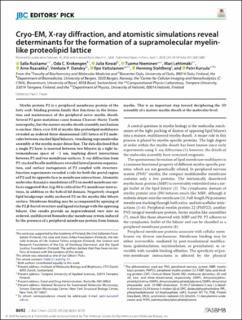| dc.contributor.author | Ruskamo, Salla | |
| dc.contributor.author | Krokengen, Oda Caspara | |
| dc.contributor.author | Kowal, Julia | |
| dc.contributor.author | Nieminen, Tuomo | |
| dc.contributor.author | Lehtimäki, Mari | |
| dc.contributor.author | Raasakka, Arne | |
| dc.contributor.author | Dandey, Venkata P | |
| dc.contributor.author | Vattulainen, Ilpo | |
| dc.contributor.author | Stahlberg, Henning | |
| dc.contributor.author | Kursula, Petri | |
| dc.date.accessioned | 2021-06-29T15:38:14Z | |
| dc.date.available | 2021-06-29T15:38:14Z | |
| dc.date.created | 2021-02-12T15:10:27Z | |
| dc.date.issued | 2020 | |
| dc.identifier.issn | 0021-9258 | |
| dc.identifier.uri | https://hdl.handle.net/11250/2762416 | |
| dc.description.abstract | Myelin protein P2 is a peripheral membrane protein of the fatty acid–binding protein family that functions in the formation and maintenance of the peripheral nerve myelin sheath. Several P2 gene mutations cause human Charcot-Marie-Tooth neuropathy, but the mature myelin sheath assembly mechanism is unclear. Here, cryo-EM of myelin-like proteolipid multilayers revealed an ordered three-dimensional (3D) lattice of P2 molecules between stacked lipid bilayers, visualizing supramolecular assembly at the myelin major dense line. The data disclosed that a single P2 layer is inserted between two bilayers in a tight intermembrane space of ∼3 nm, implying direct interactions between P2 and two membrane surfaces. X-ray diffraction from P2-stacked bicelle multilayers revealed lateral protein organization, and surface mutagenesis of P2 coupled with structure-function experiments revealed a role for both the portal region of P2 and its opposite face in membrane interactions. Atomistic molecular dynamics simulations of P2 on model membrane surfaces suggested that Arg-88 is critical for P2-membrane interactions, in addition to the helical lid domain. Negatively charged lipid headgroups stably anchored P2 on the myelin-like bilayer surface. Membrane binding may be accompanied by opening of the P2 β-barrel structure and ligand exchange with the apposing bilayer. Our results provide an unprecedented view into an ordered, multilayered biomolecular membrane system induced by the presence of a peripheral membrane protein from human myelin. This is an important step toward deciphering the 3D assembly of a mature myelin sheath at the molecular level. | en_US |
| dc.language.iso | eng | en_US |
| dc.publisher | Elsevier | en_US |
| dc.rights | Navngivelse 4.0 Internasjonal | * |
| dc.rights.uri | http://creativecommons.org/licenses/by/4.0/deed.no | * |
| dc.title | Cryo-EM, X-ray diffraction, and atomistic simulations reveal determinants for the formation of a supramolecular myelin-like proteolipid lattice | en_US |
| dc.type | Journal article | en_US |
| dc.type | Peer reviewed | en_US |
| dc.description.version | publishedVersion | en_US |
| dc.rights.holder | Copyright 2020 Ruskamo et al. | en_US |
| cristin.ispublished | true | |
| cristin.fulltext | original | |
| cristin.qualitycode | 2 | |
| dc.identifier.doi | 10.1074/jbc.RA120.013087 | |
| dc.identifier.cristin | 1889293 | |
| dc.source.journal | Journal of Biological Chemistry | en_US |
| dc.source.pagenumber | 8692-8705 | en_US |
| dc.identifier.citation | Journal of Biological Chemistry. 2020, 295 (26), 8692-8705. | en_US |
| dc.source.volume | 295 | en_US |
| dc.source.issue | 26 | en_US |

